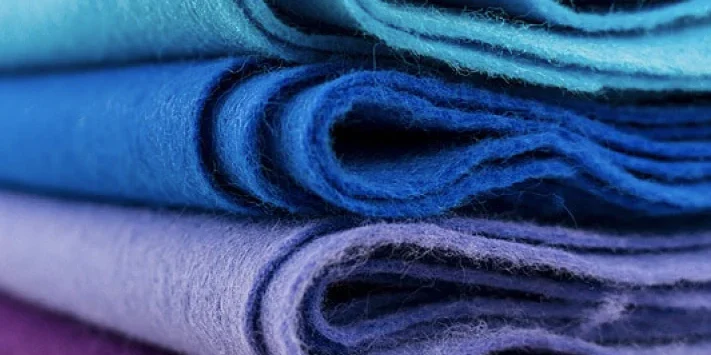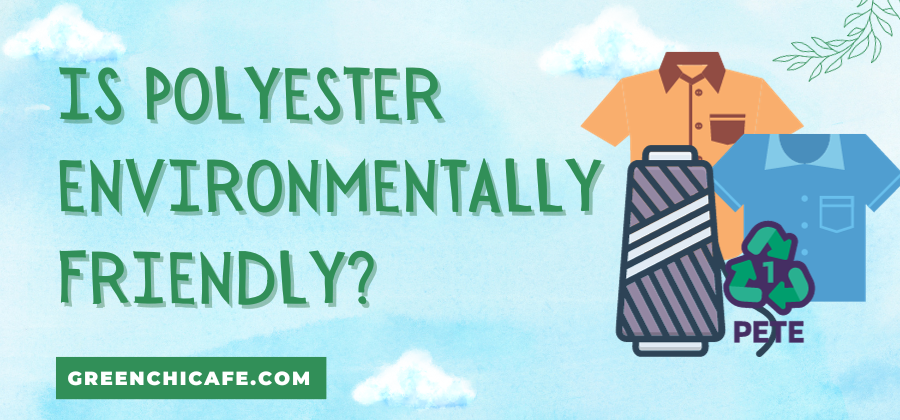Polyester is one of the most common synthetic fibers used in textiles today.
It’s known for its durability, elasticity, and affordability.
But is this popular fabric actually good for the environment? Let’s take a closer look.
Is Polyester Environmentally Friendly?

No, polyester is generally not an environmentally friendly fabric.
Polyester is made from non-renewable petroleum resources, requires a lot of energy to produce, and results in the shedding of microplastic fibers into waterways when washed.
More eco-friendly fabrics include organic cotton, wool, silk, hemp, and linen.
Key Points
- Polyester is made from non-renewable petroleum
- Polyester production emits large amounts of greenhouse gases
- Polyester sheds microfibers that pollute waterways when washed
Our Opinion
While polyester clothing may seem inexpensive and durable, its environmental impact is too high.
We believe natural fibers like organic cotton and wool are better options for most clothing.
For athletic wear that requires synthetics, recycled polyester is preferable to virgin polyester.
Overall, we think polyester should be avoided when possible due to its large carbon footprint and microfiber pollution.
Is Polyester Biodegradable?

Unfortunately, polyester is not biodegradable. It’s made from polyethylene terephthalate, a type of plastic derived from petroleum. Unlike natural fibers like cotton, wool, and silk that biodegrade within months, polyester can take hundreds of years to break down.
This means polyester clothing and other textiles made from this synthetic material will persist in landfills for an extremely long time. And when polyester garments are washed, they shed microplastic fibers that contribute to microfiber pollution in waterways.
Some solutions to reduce polyester’s environmental impact include:
- Washing synthetic fabrics in a Guppyfriend bag to catch shed microfibers
- Choosing recycled polyester made from plastic bottles diverted from landfills
- Opting for natural fibers like organic cotton that fully biodegrade
While virgin polyester requires significant energy and crude oil to produce, recycled polyester has a smaller environmental footprint. However, polyester’s lack of biodegradability makes it difficult to call this synthetic fiber truly eco-friendly.
What is Polyester Made From?

Polyester is made from petroleum-derived chemicals. The main raw material used to produce polyester is polyethylene terephthalate (PET), which is a petroleum-based compound. PET is synthesized from petroleum-derived ethylene glycol and terephthalic acid.
To make polyester fiber, PET chips are melted and extruded through spinnerets to create long filaments that can be woven or knitted into fabric. Additional chemicals and dyes are applied during the manufacturing process to give polyester desired properties like stretch, moisture wicking, and colorfastness.
The polyester production process requires significant amounts of water and energy. Large amounts of crude oil are also needed to derive the petrochemical feedstocks.
While polyester is not a natural fiber, some brands are now producing polyester synthetically from plant-based materials. This bio-based polyester uses ethanol derived from renewable resources instead of petroleum. However, the manufacturing process is similar.
How is Polyester Produced?
The production of polyester into fiber and fabric involves several steps:
- Polymerization – Ethylene glycol and terephthalic acid are reacted together through a polycondensation reaction to form the PET polymer. This reaction requires heat and catalysts.
- Melt Spinning – The PET polymer is melted and extruded through spinnerets to form individual polyester filaments. This is similar to how synthetic fibers like nylon are made.
- Drawing – The polyester filaments are stretched and drawn out to align the polymer chains and impart strength.
- Texturing – The filaments may be textured to give bulk, stretch, and insulating properties. Methods like air jet texturing or false twist texturing are used.
- Spinning – The textured filaments are spun into yarns ready for weaving or knitting.
- Dyeing – The polyester yarn or fabric is dyed to color it as desired. Disperse dyes are used as polyester does not readily absorb dyes.
- Finishing – Additional finishes or treatments may be applied to provide water resistance, fire retardance, stretch, and other properties.
The production of polyester is an energy and resource-intensive process. While recycled PET helps reduce environmental impact, manufacturing virgin polyester from petrochemicals requires significant amounts of water, energy, and crude oil resources. The textile industry continues to explore bio-based polyester and other more sustainable alternatives.
Does Polyester Release Microplastics?
Yes, polyester fabrics shed microscopic plastic fibers when washed, contributing to microplastic pollution in waterways. Polyester is made of polyethylene terephthalate (PET), a form of plastic. When polyester garments are washed, friction causes tiny plastic fibers to break off and enter wastewater.
These microfibers are too small to be filtered out by most wastewater treatment plants and end up flowing into rivers, lakes, and oceans. Here, aquatic life can mistake them for food. The fibers also absorb toxins and can transfer them up the food chain to fish and humans.
Polyester microfibers are a significant contributor to the microplastic pollution in waterways. Some estimates suggest polyester garments could shed hundreds of thousands of microfibers per wash load.
Consumers can take steps to curb microfiber shedding and prevent microplastic pollution:
- Wash polyester less frequently and use gentler cycles
- Use a Guppyfriend or other microfiber-catching bag
- Buy apparel made of natural fibers like cotton, wool, linen
- Choose recycled polyester over virgin polyester
- Dispose of synthetic materials properly, not into waterways
The textile industry is also exploring alternative finishes and production methods to make polyester shed less while retaining its durability, elasticity, and low cost.
Is Polyester Recyclable?
Yes, polyester is one of the most recyclable fabrics. It can be recycled repeatedly into new polyester fiber without loss of quality. Recycled polyester provides an environmentally-friendly option compared to virgin polyester made from non-renewable petroleum sources.
The most common type of polyester, polyethylene terephthalate (PET), is easily recycled. PET bottles and containers can be collected, shredded, melted, and re-spun into recycled polyester fiber. This diverts waste from landfills and reduces the need for new polyester production.
Clothing manufacturers are increasingly using recycled polyester in fabrics. Patagonia has led the way, making fleece jackets from recycled PET bottles since 1993. Now major brands like Levi’s, The North Face, Adidas, and H&M also use recycled polyester in their apparel lines.
Consumers can support recycled polyester by:
- Buying clothes containing recycled polyester – check garment tags
- Donating used polyester clothing for recycling
- Recycling PET bottles and containers
Widespread polyester recycling and innovation in chemical recycling processes can further improve the sustainability of this versatile, durable synthetic material. With proper care and disposal, polyester can be an environmentally friendly fiber option.
FAQ
Is Polyester Harmful to the Environment?
Yes, polyester is harmful to the environment in several ways. It is made from non-renewable petroleum resources. Producing polyester emits a large amount of CO2 and other greenhouse gases. Polyester fabrics also shed microfibers when washed, polluting waterways. These microfibers contain toxins and do not biodegrade.
Is 100% Polyester Environmentally Friendly?
No, 100% polyester is generally not an environmentally friendly fabric. It is made from non-renewable resources, emits greenhouse gases, and sheds polluting microfibers. Some more sustainable options are recycled polyester, recycled nylon, organic cotton, wool, silk, hemp, and linen.
Is Polyester More Environmentally Friendly Than Cotton?
No, polyester is generally less environmentally friendly than cotton. Polyester production emits almost double the CO2 emissions of cotton production. Polyester also sheds microfibers whereas cotton is biodegradable. However, cotton does require a significant amount of water and pesticides to grow. Overall, cotton has a lower environmental impact than polyester.
What Are the Ethical Issues With Polyester?
Some ethical issues with polyester production include its reliance on fossil fuels, its contribution to climate change and microfiber pollution, and potential human rights violations in petroleum extraction. Polyester production also creates pollution which can impact communities located near factories. Recycled polyester helps mitigate some of these concerns.
Conclusion
Polyester is not an environmentally friendly fabric overall due to its production from non-renewable resources, high energy use, and microfiber pollution. While cotton has sustainability issues as well, it biodegrades quickly and has a lower carbon footprint than polyester. Recycled polyester and nylon are better options than virgin polyester. Choosing natural fibers like organic cotton, wool, silk, hemp, and linen are more sustainable alternatives to regular polyester use.
